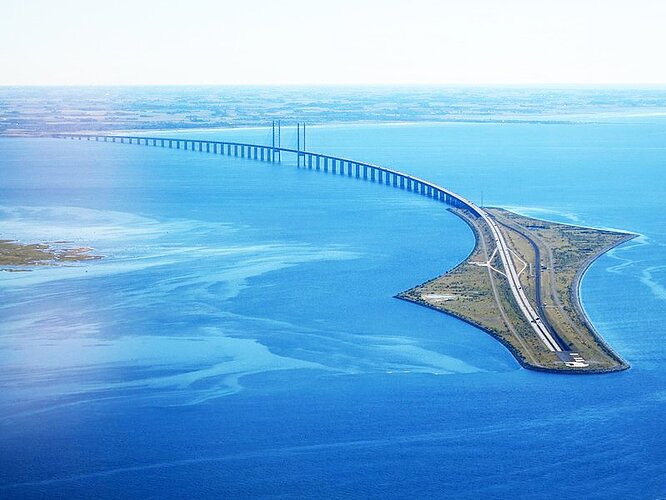Bridging Borders: The Epic Saga of the Oresund Bridge
In the annals of modern engineering marvels, few structures rival the grandeur and ingenuity of the Oresund Bridge. Spanning the Oresund Strait between Denmark and Sweden, this monumental feat of human endeavor stands as the longest bridge in Europe, linking the Scandinavian peninsula with the continental mainland. But beyond its impressive dimensions, the Oresund Bridge is a symbol of cooperation, innovation, and cross-border connectivity that transcends national boundaries.
A Confluence of Engineering Excellence
The genesis of the Oresund Bridge dates back to the late 20th century when the need for a direct transit link between Denmark and Sweden became increasingly apparent. With the advent of globalization and the growing importance of regional integration, the idea of a combined railway and motorway bridge gained traction as a means to facilitate trade, travel, and cultural exchange.
The design and construction of the bridge posed formidable challenges to engineers and architects tasked with bridging the gap between two nations while accommodating the needs of shipping traffic and air travel. The solution lay in a hybrid structure that seamlessly integrated a bridge and a tunnel, ensuring unimpeded passage for both land and sea transportation.
Engineers devised a cable-stayed bridge with a towering height of 204 meters and a width of 23.5 meters, providing ample clearance for maritime vessels while minimizing interference with nearby air traffic, particularly at Copenhagen Airport. The bridge portion, stretching nearly 8 kilometers, serves as a majestic gateway spanning the azure waters of the Oresund.
The Subterranean Passage: Drogden Tunnel
Beneath the tranquil surface of the Oresund lies the Drogden Tunnel, a subterranean marvel stretching 4 kilometers from the artificial island of Peberholm to the Danish island of Amager. This underwater conduit, the longest of its kind in the world, represents the pinnacle of engineering innovation, allowing seamless transit for both road and rail traffic.
Construction of the tunnel involved meticulous planning and execution, with workers laboring tirelessly to dredge a trench in the seabed and lower prefabricated concrete segments into place. Each segment, weighing up to 55,000 tonnes, was meticulously crafted and sealed to withstand the relentless pressure of the surrounding waters.
The completion of the Drogden Tunnel marked a triumph of human ingenuity over the forces of nature, providing a vital link in the seamless transit network connecting Denmark and Sweden.
From Concept to Reality: The Construction Saga
The realization of the Oresund Bridge was no small feat, requiring years of planning, coordination, and Herculean construction efforts. In 1995, the prestigious design-build contract was awarded to Sundlink, setting in motion a monumental construction endeavor that would span four years and involve thousands of workers.
One of the primary challenges faced by engineers was the need to accommodate both road and rail traffic on the same structure, necessitating a design that could withstand the dynamic forces exerted by trains traversing the bridge. The decision to opt for a cable-stayed design, rather than a traditional suspension bridge, proved instrumental in ensuring stability and safety for all modes of transportation.
Construction crews worked tirelessly to erect the massive towers and lay the foundation for the bridge, employing state-of-the-art techniques and equipment to overcome logistical challenges and environmental constraints. The result was a monumental structure that seamlessly integrated road and rail infrastructure, serving as a lifeline for commuters, tourists, and cargo alike.
Environmental Stewardship and Ecological Impact
While the construction of the Oresund Bridge was a triumph of human ingenuity, it was also a testament to the importance of environmental stewardship and ecological preservation. Throughout the construction process, engineers took great care to minimize the project’s impact on the surrounding marine ecosystem, employing innovative techniques to protect fragile habitats and mitigate disturbance to marine life.
The creation of Peberholm, an artificial island formed from dredged seafloor material, exemplifies this commitment to environmental sustainability. Today, Peberholm serves as a thriving ecosystem, home to over 500 species of plants and a sanctuary for biologists and environmental researchers.
Legacy and Beyond: A Bridge to the Future
As we reflect on the epic saga of the Oresund Bridge, we are reminded of the transformative power of human collaboration and ingenuity. Beyond its role as a vital transit artery, the bridge stands as a symbol of Nordic cooperation, economic prosperity, and regional integration.
In the decades since its completion, the Oresund Bridge has become an iconic landmark, attracting visitors from around the world and serving as a testament to the enduring bonds between Denmark and Sweden. As we look to the future, the bridge serves as a beacon of hope and inspiration, guiding us towards a world where borders are bridged, and nations unite in pursuit of common goals.
In the end, the Oresund Bridge is more than just a marvel of modern engineering; it is a testament to the boundless potential of human imagination and the enduring spirit of collaboration that transcends national boundaries.
